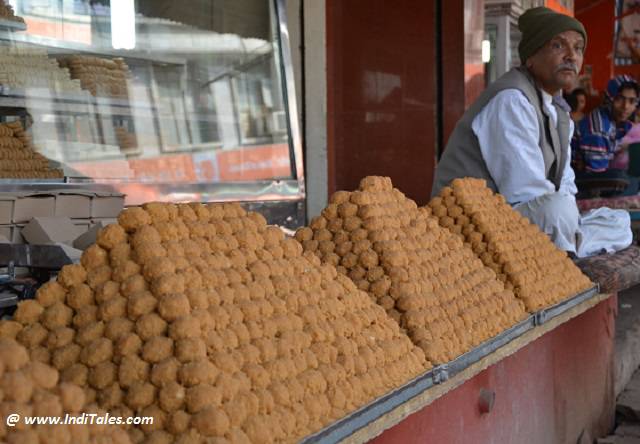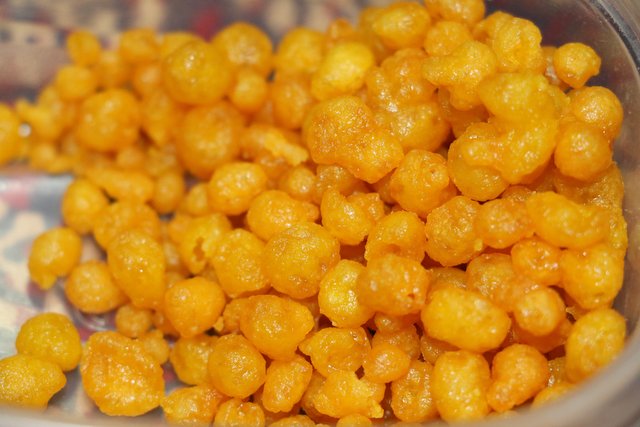11 TEMPLE PRASAD YOU MUST TASTE IN INDIA
11 TEMPLE PRASAD YOU MUST TASTE IN INDIA
Temple Prasad is the divine food that you get in temples across India. It is the food that we offer to the deity, who blesses it merely by coming in contact with the food. When offered it is called Naivaidayam and once offered it becomes the divine prasad.
There are many different types of Prasad offered in different temples. The food offered is as per the deity’s choice. It also depends on the region where the temple is – our deities really consume the local food.
Temple Prasad from India
Come with me to feel the bliss of temple prasad across India.
Mahaprasad at Jagannath Puri
Puri is the Anna Kshetra of Jagannath. It is meant to be a place where God himself comes to eat. No wonder then that the Jagannath Puri kitchen is the biggest kitchen in the world. It also uses the traditional way to cook in fresh clay pots every day using the water from two wells within the temple premises.

The food cooked is a whole meal that is cooked by the Brahmins or Sevayats of the temple. However, it is believed that the Mahalakshmi – the consort of the Jagannath herself looks over the kitchen. The prasad is first offered to Jagannath after which it becomes Prasad. It is then offered to Mahalakshmi, after which it becomes Mahaprasad.
You can visit the kitchen in the morning to see the cooking. Later in the day you can visit Anand Bazaar and get the prasad which includes rice, daal, vegetables, and lots of sweets. In fact, people in and around Puri take the temple food for any functions at their homes.
To take home, dry items like Khaja are packed in neatly carved palm leaf boxes.
Tirupati Laddu
Who does not like Laddus from Tirupati Balaji? It is a unique Laddu with its own GI tag that every Balaji devotee craves. Though it is made of the same ingredients that many laddus are made of – Gram Flour, Ghee, Sugar, Nuts and Spices, its secret ingredient is the devotion that goes into it. After all, it is made to be offered to Venkateshwara – the one who lives on Tirumala hills.
 Made in lakhs within the temple precincts, each laddu weighs about 200 gms and is offered to devotees after they have visited the temple. The taste is divine and the phrase – you just can’t have one, seems to be written for it. No wonder people not just eat but also pick up for taking it back home with them.
Made in lakhs within the temple precincts, each laddu weighs about 200 gms and is offered to devotees after they have visited the temple. The taste is divine and the phrase – you just can’t have one, seems to be written for it. No wonder people not just eat but also pick up for taking it back home with them.
Makhan Mishri at Krishna Temples
Krishna’s childhood stories are full of his fondness for Makhan or butter. There is ample poetry talking about his stealing the butter and then his naughty exchanges with his mother Yashoda. So, it is natural that his temples offer Makhan along Mishri as Prasad.

This prasad is usually offered in the mornings as Krishna likes to eat Makhan in the morning. Many Krishna temples offer Makhan Mishri prasad but I remember two temples where I have had it very fondly. The first one is the famous Banke Bihari temple in Vrindavan – the very land where Krishna lived as a youngster. Second is the Dwarkadhish temple in Dwarka – the golden city that he built on the west coast.
I remember asking for multiple helpings as I loved eating the freshly churned butter with a bit of sweetness of Mishri. Even today I am thankful to the generous lady who was distributing the prasad that day.
Dried Apple in Vaishno Devi Temple Prasad
Vaishno Devi sits on top of Trikuta Parvat, near Jammu. In North India, her’s is the most visited shrine. They say you visit her only when you get her ‘Bulawa’ or call. I am yet to get that call despite living in the vicinity many times. However, I have been fortunate enough to receive the prasad from Ma Vaishno Devi many times.

You get Murmura or puffed rice, Ilaichidana or sugar balls, some dry fruits and sun-dried apples. Dried apples are unique to the prasad of Ma Vaishno Devi. They last for a long time, so you can take them back home, and keep them for people you may meet after some time. They also carry the essence of the apple-growing region around the temple. For me, they carry a lot of childhood memories.
Lal Peda at Sankat Mochan Temple in Kashi
The famous Hanuman temple was built by Goswami Tulsidas ji, who is the author of not just Ramcharitmanas but also Hanuman Chalisa – the most chanted verses to Hanuman. It is said that he saw Hanuman ji here and later built a temple. The temple is dominated by monkeys.

There are two kinds of prasad that are very popular here – one is Besan Ke Laddu and the second is Lal Peda. You can see a row of shops on either side of the road leading to the temple. My favorite is Lal Peda – it has a unique taste of well-roasted milk. Other popular pedas of course are Mathura Peda in Braj and Dharwad Peda in Karnataka.
Kadha Prasad at Gurudwaras
I grew up in Chandigarh and around. Visiting Gurudwaras was a part of our routine. As kids we looked forward to the Kadha Prasad. The wheat halwa dripped in pure desi ghee tastes like heaven. We would extend one hand and then another to receive an extra helping of Kadha.

Though the most famous prasad is at the Langar in Harmandir Sahib in Amritsar, you get the blissful Kadha prasad at most Gurudwaras. Somehow you can never get the same taste at home though the recipe is pretty common and ingredients limited. Probably the taste of divine blessings gets added to it.
Tuesday Bundi at Hanuman Mandirs
In North India, visiting Hanuman temples on Tuesdays is a tradition with many families. We also visited as kids. Huge piles of bright orange Bundi can be seen outside the Hanuman temples, especially in the evenings. This is a weekly affair, and you hardly get any Bundi on the other six days of the week. It tastes like Jalebi but comes in the form of small balls that melt in the mouth. There are soft and crisp varieties, I like the latter but there are those who like soft ones.

As kids, we would typically buy a small packet from the shop outside, visit the temple and hand it to the Pujari ji. He would put some in the common pool and return the rest to us and then give a small handful from the common pool to us as prasad. We loved the prasad so much that we would try to get as much as possible.
I miss it big time in south India. If I am in the North on a Tuesday, I still try to visit a Hanuman temple, and somewhere the kid inside me still craves the Bundi Temple Prasad.
Modak at Ganapatiphule

Modaks are a part of Ganapati Puja. Most of the time I have had them at Maharashtrian friends’ homes during Ganapati Utsava. However, I found them being served at Ganapati Temple at Ganapatiphule on the Konkan coast of Maharashtra. The temple though popular is usually not crowded, so you can easily get the Modak. It is even served by the eateries around the temple. Needless to say, it tastes heavenly.
Kanchipuram Idli at Varadaraja Perumal Temple
Kanchipuram is a divine city centered around the temple of Kanchi Kamakshi with Shiva Kanchi and Vishnu Kanchi in its folds. Full of Kanchipuram Silk Sari shops and temples, its multi-grain Idli is a must-have delicacy in Kanchipuram.

It is served in almost all eateries but as temple prasad you get it at the Varadaraja Perumal Temple at the heart of Vishnu Kanchi. I missed tasting it at the temple though I spent more than half a day there. I did have it at various eateries though.
Thor at Nathdwara
Most Vishnu temples across the country have elaborate kitchens that prepare different meals for the deity who loves to eat. At the Nathdwara Thakur Haveli the elaborate kitchen prepares several meals throughout the day for the young Srinathji using local vegetables and fruits. The food changes with the weather just like it changes in our home kitchens.

What is unique in the prasad here is Thor – a sweet dish made with Suji or Semolina and soaked in Chaashni or sugar syrup. Thor is the specialty of Nathdwara though it is now available at select e-portals.
Bangles as Temple Prasad

At Devi temples, it is common to offer the Shringar for the Devi. It typically involves clothes, be it a Sari or a Chunri, Bindi, Bangles, Haldi, Kumkum and jewelry. At some temples, women also get a part of this shringar back. I remember receiving red glass bangles at Nidhi Van in Vrindavan and at the Mahalakshmi temple in the premises of Jagannath Puri Temple. They are my prized possessions and I wear them often.
Common Temple Prasad at Various Temples
Besides these specialties at specific temples, there are common prasads that you get in almost every temple. Panchamrita or Charanamrita, sometimes also called Tirtha is the most common offering at temples. You get it at any time you visit the temple, typically in your right hand. In North India Peda and Laddus are common prasad in most temples. You see rows of Mithai shops selling them outside temples. In South India, it is Payasam or the temple food that everyone looks forward to. Puffed rice and Ilaichidana are common dry prasad to take home with you.

What makes temple prasad special is the devotion with which it is prepared, offered to the deity, and then to the devotee and the devotion with which it is received and eaten. It is an invisible thread that infuses the divine energy in the food we eat.

Comments
Post a Comment